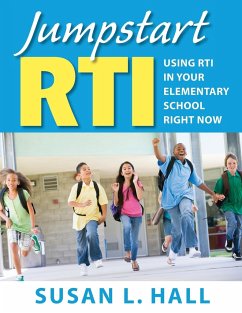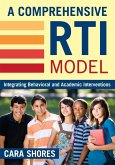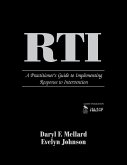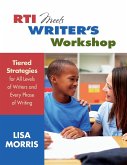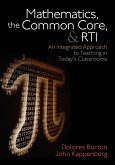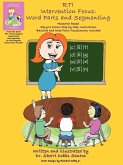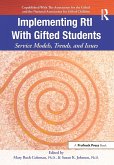- Broschiertes Buch
- Merkliste
- Auf die Merkliste
- Bewerten Bewerten
- Teilen
- Produkt teilen
- Produkterinnerung
- Produkterinnerung
Improve all students' reading skills with this research-based book packed with practical tools for implementing RTI quickly, efficiently, and successfully. Downloadable forms are available online.
Andere Kunden interessierten sich auch für
![A Comprehensive RTI Model A Comprehensive RTI Model]() Cara ShoresA Comprehensive RTI Model41,99 €
Cara ShoresA Comprehensive RTI Model41,99 €![RTI RTI]() Daryl F. MellardRTI42,99 €
Daryl F. MellardRTI42,99 €![RTI Meets Writer's Workshop RTI Meets Writer's Workshop]() Lisa MorrisRTI Meets Writer's Workshop33,99 €
Lisa MorrisRTI Meets Writer's Workshop33,99 €![Mathematics, the Common Core, and RTI Mathematics, the Common Core, and RTI]() Dolores BurtonMathematics, the Common Core, and RTI41,99 €
Dolores BurtonMathematics, the Common Core, and RTI41,99 €![Jumpstart! Philosophy in the Classroom Jumpstart! Philosophy in the Classroom]() Steve BowkettJumpstart! Philosophy in the Classroom38,99 €
Steve BowkettJumpstart! Philosophy in the Classroom38,99 €![RTI Intervention Focus RTI Intervention Focus]() Sherri Dobbs SantosRTI Intervention Focus22,99 €
Sherri Dobbs SantosRTI Intervention Focus22,99 €![Implementing RtI With Gifted Students Implementing RtI With Gifted Students]() Mary Ruth ColemanImplementing RtI With Gifted Students53,99 €
Mary Ruth ColemanImplementing RtI With Gifted Students53,99 €-
-
-
Improve all students' reading skills with this research-based book packed with practical tools for implementing RTI quickly, efficiently, and successfully. Downloadable forms are available online.
Hinweis: Dieser Artikel kann nur an eine deutsche Lieferadresse ausgeliefert werden.
Hinweis: Dieser Artikel kann nur an eine deutsche Lieferadresse ausgeliefert werden.
Produktdetails
- Produktdetails
- Verlag: Corwin
- Seitenzahl: 146
- Erscheinungstermin: 16. Februar 2011
- Englisch
- Abmessung: 280mm x 216mm x 8mm
- Gewicht: 387g
- ISBN-13: 9781412981729
- ISBN-10: 1412981727
- Artikelnr.: 31566483
- Herstellerkennzeichnung
- Libri GmbH
- Europaallee 1
- 36244 Bad Hersfeld
- gpsr@libri.de
- Verlag: Corwin
- Seitenzahl: 146
- Erscheinungstermin: 16. Februar 2011
- Englisch
- Abmessung: 280mm x 216mm x 8mm
- Gewicht: 387g
- ISBN-13: 9781412981729
- ISBN-10: 1412981727
- Artikelnr.: 31566483
- Herstellerkennzeichnung
- Libri GmbH
- Europaallee 1
- 36244 Bad Hersfeld
- gpsr@libri.de
Susan L. Hall is founder and president of the 95 Percent Group Inc., which focuses on early childhood reading education and small-group intervention to give 95% of kindergarten through third grade students the opportunity to read at or above their grade level. A frequent speaker and lecturer, she also serves on the advisory board of the Neuhaus Education Center. Hall is a member of the Reading First Review Panel for state grant proposals and is also a Sopris West certified trainer for DIBELS (Dynamic Indicators of Basic Early Literacy Skills) and LETRS® (Language Essentials for Teachers of Reading and Spelling). She is the author of I¿ve DIBEL¿d, Now What?, and a co-author with Louisa C. Moats of two books, Straight Talk About Reading and Parenting a Struggling Reader. Hall earned her bachelor¿s degree at Lawrence University, her master¿s degree from Harvard University, and her doctorate of education from National-Louis University.
Publisher¿s Acknowledgments
About the Author
Introduction
Why This Book Is Needed
Overview of the Contents
1. Ninety-five Percent of Students at Benchmark Is Achievable: A District
Example
New Approach
What Level of Success Is Possible?
Professional Development
Next Steps
Conclusion
2. Getting Ready
Motivating Staff: ?Call to Action?
Build Buy-In
Create the RTI Team
Planning Period
Conclusion
3. Getting Started
Create an Assessment Plan
Select a Delivery Model
Add Intervention Blocks
Year 1: First Half
Conclusion
4. Analyzing Data and Forming Groups
Curriculum-Based Assessment
Diagnostic Assessment
Progress Monitoring
Regrouping Cycle
Systems to Manage the Data
Year 1: Second Half
Conclusion
5. Delivering Effective Intervention Instruction
Characteristics of Effective Intervention Instruction
Other Considerations
Intervention Materials and Programs
Conclusion
6. Initiating a Problem-Solving Process
Grade-Level Team Meetings
Problem-Solving Meetings
RTI Team Meetings
Conclusion
7. Referring a Student for Special Education Testing
RTI and Special Education
Change in Role of Special Education Staff
Communication With Parents
Conclusion
Bibliography
Index
About the Author
Introduction
Why This Book Is Needed
Overview of the Contents
1. Ninety-five Percent of Students at Benchmark Is Achievable: A District
Example
New Approach
What Level of Success Is Possible?
Professional Development
Next Steps
Conclusion
2. Getting Ready
Motivating Staff: ?Call to Action?
Build Buy-In
Create the RTI Team
Planning Period
Conclusion
3. Getting Started
Create an Assessment Plan
Select a Delivery Model
Add Intervention Blocks
Year 1: First Half
Conclusion
4. Analyzing Data and Forming Groups
Curriculum-Based Assessment
Diagnostic Assessment
Progress Monitoring
Regrouping Cycle
Systems to Manage the Data
Year 1: Second Half
Conclusion
5. Delivering Effective Intervention Instruction
Characteristics of Effective Intervention Instruction
Other Considerations
Intervention Materials and Programs
Conclusion
6. Initiating a Problem-Solving Process
Grade-Level Team Meetings
Problem-Solving Meetings
RTI Team Meetings
Conclusion
7. Referring a Student for Special Education Testing
RTI and Special Education
Change in Role of Special Education Staff
Communication With Parents
Conclusion
Bibliography
Index
Publisher¿s Acknowledgments
About the Author
Introduction
Why This Book Is Needed
Overview of the Contents
1. Ninety-five Percent of Students at Benchmark Is Achievable: A District
Example
New Approach
What Level of Success Is Possible?
Professional Development
Next Steps
Conclusion
2. Getting Ready
Motivating Staff: ?Call to Action?
Build Buy-In
Create the RTI Team
Planning Period
Conclusion
3. Getting Started
Create an Assessment Plan
Select a Delivery Model
Add Intervention Blocks
Year 1: First Half
Conclusion
4. Analyzing Data and Forming Groups
Curriculum-Based Assessment
Diagnostic Assessment
Progress Monitoring
Regrouping Cycle
Systems to Manage the Data
Year 1: Second Half
Conclusion
5. Delivering Effective Intervention Instruction
Characteristics of Effective Intervention Instruction
Other Considerations
Intervention Materials and Programs
Conclusion
6. Initiating a Problem-Solving Process
Grade-Level Team Meetings
Problem-Solving Meetings
RTI Team Meetings
Conclusion
7. Referring a Student for Special Education Testing
RTI and Special Education
Change in Role of Special Education Staff
Communication With Parents
Conclusion
Bibliography
Index
About the Author
Introduction
Why This Book Is Needed
Overview of the Contents
1. Ninety-five Percent of Students at Benchmark Is Achievable: A District
Example
New Approach
What Level of Success Is Possible?
Professional Development
Next Steps
Conclusion
2. Getting Ready
Motivating Staff: ?Call to Action?
Build Buy-In
Create the RTI Team
Planning Period
Conclusion
3. Getting Started
Create an Assessment Plan
Select a Delivery Model
Add Intervention Blocks
Year 1: First Half
Conclusion
4. Analyzing Data and Forming Groups
Curriculum-Based Assessment
Diagnostic Assessment
Progress Monitoring
Regrouping Cycle
Systems to Manage the Data
Year 1: Second Half
Conclusion
5. Delivering Effective Intervention Instruction
Characteristics of Effective Intervention Instruction
Other Considerations
Intervention Materials and Programs
Conclusion
6. Initiating a Problem-Solving Process
Grade-Level Team Meetings
Problem-Solving Meetings
RTI Team Meetings
Conclusion
7. Referring a Student for Special Education Testing
RTI and Special Education
Change in Role of Special Education Staff
Communication With Parents
Conclusion
Bibliography
Index

